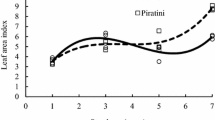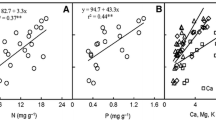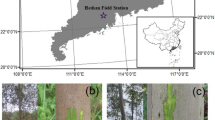Abstract
A hinoki stand was divided into the following two layers: one was a leafed upper layer consisting of leaves and woody elements, such as stems, living branches and dead branches; the other was a leafless layer consisted of woody elements, such as stems and dead branches. Photosynthetic photon flux density (PPFD) penetrating through the stand was measured in relation to the silhouette area of leaves and woody elements. The silhouette area, on a ground area basis, was 11.2 ha ha−1 for leaves (leaf area index), 0.26 ha ha−1 for stems, 0.40 ha ha−1 for living branches and 0.69 ha ha−1 for dead branches, yielding a total wood silhouette area of 1.35 ha ha−1. The apparent extinction coefficient,K, was computed to be 0.420 ha−1 ha for the leafed layer, while the extinction coefficient of woody elements,K c, was computed to be 1.01 ha−1 ha for the leafless layer. The cumulative wood silhouette area density from the top of the canopy down to a given depth increased with an increase in the corresponding leaf area density within the leafed layer. The extinction coefficient of leaves,K F, was estimated to be 0.367 ha−1 ha. Of the PPFD extinguished within the canopy, the fraction (K F/K) due to leaves alone was evaluated to be 87.4%.
Similar content being viewed by others
References
Baldocchi D. D., Matt D. R., Hutchison B. A. &McMillen R. T. (1984) Solar radiation within an oak-hickory forest: An evaluation of the extinction coefficients for several radiation components during fully-leafed and leafless periods.Agric. For. Meteorol. 32: 307–322.
Federer C. A. (1971) Solar radiation absorption by leafless hardwood forests.Agric. For. Meteorol. 9: 3–20.
Hagihara A. (1987) On the estimation of photosynthetic production by forest canopies.Jpn. J. Ecol. 37: 123–132 (in Japanese with English summary).
Hagihara A. &Hozumi K. (1986) An estimate of the photosynthetic production of individual trees in aChamaecyparis obtusa plantation.Tree Physiol. 1: 9–20.
Hagihara A., Ninomiya I. &Hozumi K. (1982) Evaluation of the light climate in aChamaecyparis obtusa plantation by a chemical light-meter.J. Jpn. For. Soc. 64: 220–228.
Hutchison B. A., Matt D. R., McMillen R. T., Gross L. J., Tajchman S. J. &Norman J. M. (1986) The architecture of deciduous forest canopy in eastern Tennesse, U.S.A.J. Ecol. 74: 635–646.
Kurachi N., Hagihara A. &Hozumi K. (1986) Evaluation of the light interception by non-photosynthetic organs in aLarix leptolepis plantation.Ecol. Res. 1: 173–183.
Kurachi N., Hagihara A. &Hozumi K. (1989) Effect of light interception by non-photosynthetic organs on canopy photosynthetic production.Ecol. Res. 4: 187–197.
Kuroiwa S. (1979) Photosynthesis of plant communities. In:Functions and Production of Plant Communities (ed. H. Iwaki) pp. 84–149. Asakura-Shoten, Tokyo (in Japanese).
Monsi M. &Saeki T. (1953) Über den Lichtfaktor in den Pflanzengesellschaften und seine Bedeutung für die Stoffproduktion.Jpn. J. Bot. 14: 22–52.
Mori S. &Hagihara A. (1991) Crown profile of foliage area characterized with the Weibull distribution in a hinoki (Chamaecyparis obtusa) stand.Trees 5: 149–152.
Ninomiya I., Hagihara A. &Hozumi K. (1980) Radiation penetration within a hinoki plantation.Trans. Mtg. Jpn. For. Soc. (Chubu Branch) 28: 31–33 (in Japanese).
Norman J. M. &Jarvis P. G. (1975) Photosynthesis in Sitka spruce (Picea sitchensis (Bong.) Carr.). V. Radiation penetration theory and a test case.J. Appl. Ecol. 12: 839–878.
Rauner J. L. (1976) Deciduous forests. In:Vegetation and the Atmosphere, Vol. 2, Case Studies (ed. J. L. Monteith) pp. 241–264. Academic Press, New York.
Satoo T. &Senda M. (1958) Materials for the studies of growth in stands. IV. Amount of leaves and production of wood in a young plantation ofChamaecyparis obtusa.Bull. Tokyo Univ. For. 54: 71–100 (in Japanese with English summary).
Shinozaki K., Yoda K., Hozumi K. &Kira T. (1964) A quantitative analysis of plant form — the pipe model theory. I. Basic analyses.Jpn. J. Ecol. 14: 97–105.
Weibull W. (1949) A statistical analysis of the size ofCyrtoidea in albatross cores from the east Pacific Ocean.Nature 164: 1047–1048.
Whittaker R. H. &Woodwell G. M. (1967) Surface area relations of woody plants and forest communities.Am. J. Bot. 54: 931–939.
Yim, Y. J., Ogawa H. &Kira T. (1969) Light interception by stems in plant communities.Jpn. J. Ecol. 19: 233–238.
Author information
Authors and Affiliations
About this article
Cite this article
Hagihara, A., Yamaji, K. Interception of photosynthetic photon flux density by woody elements in a hinoki (Chamaecyparis obtusa [Sieb. et Zucc.] Endl.) stand. Ecol. Res. 8, 313–318 (1993). https://doi.org/10.1007/BF02347190
Accepted:
Issue Date:
DOI: https://doi.org/10.1007/BF02347190




